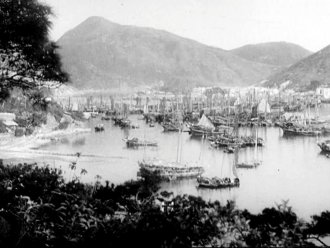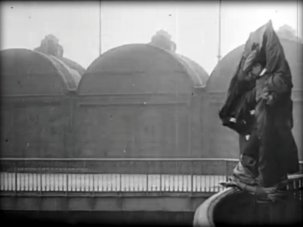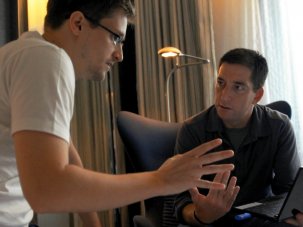Web exclusive
Before the founding of the first commercial airlines, and long before affordable tourism, one could pay to hear a travel lecturer orate his adventures overseas. During the late 1800s and early twentieth century, a handful of individuals earned recognition in the travel-lecturing field. These self-educated ethnologists explored exotic regions of the globe and, returning, toured recital halls, where they told to captive audiences – with the aid of photographic slides – what they had seen firsthand of foreign lands.
To the populace of North America, the continents of Asia and Africa were then as tenebrous, as terminally imaginary, as the obsolete six of the Seven Wonders of the World. These lectures were popular because they nourished enormous curiosity, and because their oral and eyewitness elements were improvement upon encyclopaedia: an event. A lecturer’s annotative photographs were proof, but were nothing without narration, no more enlightening than drafted artworks or the colour plates of an atlas. Not much more honest, either, when you consider that Burton Holmes, a famed travel lecturer, hand-coloured his glass slides – an effort, presumably, to make his photographs appear more true to life, when in reality he was counterfeiting facticity.
Holmes’s exercising artistic license this way was prescient, reaching forward to the future and to Technicolor film, which would within a few decades draw up alongside his ambition. Holmes and his competitors co-opted new technologies as quickly as they became available, integrating into their acts whatever might better instantiate their claims. With the invention of the film camera, they closed the gap between representation and truth, making documentary lectures known as ‘travelogues’.
The online Travel Film Archive collects multiple examples, including films by flying-naturalist couple Martin and Osa Johnson, Arctic explorer Donald MacMillan and the ‘Voice of the Globe’ James A. Fitzpatrick. The first of these movies attracted the interest of the nascent Hollywood studios, and Holmes’s studio-packaged travelogues were screened in cinemas as single-reels before features. Holmes’s young cameraman and eventual inheritor André de la Varre was another successful investment – for Warner Brothers, in the 40s – but made his name independently with his ‘Screen Traveler’ series years earlier.
His 1938 short Hong Kong: Gateway to China is available to view online, and presents a vastly different city to the one documented in the world media since 26 September, when pro-democracy campaigners began to fill the streets at multiple sites around the city, protesting the announcement that only candidates approved by Beijing’s Central Government will be eligible to run for Hong Kong executive, (doubling-back on recent promises, and the ‘One country, two systems’ agreement, to protect the autonomy of the former Cantonese-English archipelago). The popularly named Umbrella Revolution – joining students under the leadership of ‘Scholarism’ founder 17-year-old Joshua Wong, members of the civil-disobedience movement Occupy Central and, subsequently, sympathisers subscribing to neither group – has changed the very countenance of the city. Demonstrators have halted traffic, encamping across the eight-lane thoroughfare Connaught Road and other major intersections, while sit-ins – initially occupying government headquarters in Admiralty; spreading to the commercial and retail districts of Mongkok and Causeway Bay – have agitated the school and work-day calendars. Ultra-modern media, such as time-lapse video and aerial drone footage, continue to attest to the scale and impact of this influential protest.
De la Varre’s film, in high contrast, records a Hong Kong of over 75 years ago, when the island was under British imperial rule. This was 60 years before the 1997 reunification of Hong Kong and Mainland China and, though it brushes quite collectedly over the city’s contemporary politics, the film bears witness to an historical period and cultural identity, elements of which many Hong Kong citizens are fighting today to conserve.
The filmmaker, who was Wong’s age when he bought his first film camera, shot and narrated this 11-minute scenic tour of the then crown colony – beginning on the water, wending through its streets, climbing up-slope for better vantage and ending full circle, buoyed in the bay. A self-taught cameraman with, by this time, extensive experience, de la Varre had a keen sense for environment, an elegance and style. There’s creativity in his photography: in his finding alternate frames in the foliage of indigenous species of tree, or ferreting in the crowded marketplace for close-ups of local tradespeople. His camera is mellifluous, leisurely in its movements, yet dynamic. De la Varre, understanding point-of-view, mounts his camera on a rising cable tram. Capturing a vista from the mountaintop, he pans to reveal a Hong Kong man standing in the right-hand foreground. He looks at the same view we do. His clothes are buffeted by a stiff breeze, his cigarette smoke spirits away: we can almost feel the whip of the wind in his shirt.
The script is a curiosity, fascinating by its weird mix of pragmatism and floridity. It’s glutted with adjectives (de la Varre likes yokes: “enormous and valuable”, “tolerant and wise”) and admits non-circumspect statements like “seldom equaled and never surpassed”. There’s rational advice for the holidaymaker that would pass muster in the modern-day paperback guide, in his description of the bank as “air-conditioned” and assuring the shopper “a paradise of bargains”. These two registers can occasionally and amusingly come together in a single sentence, as at 7m 18s: “The fleet cable tram travels to the top station, 1,300 feet above the sea, in seven minutes, and inhabitants of the colony call this gliding climb a shortcut to fairy land.” Meanwhile a mercurial orchestral score – now spry, now romantic – is so suggestive of story and character, it seems to gesture to a fictional narrative – a South China-set theatrical, perhaps – beyond the film’s non-narrative agenda.
That the filmmaker embroiders in utopianist overtones the island’s social and political welfare – its people “contented”, and “proud” as the colony is “Britain’s pride of the East” – is interesting, since de la Varre had no motive to sell the city, not being liable to any partial, funding body. Rather, his film has retained the roadshow roots of travel lecturing, which appealed foremost to the escapist desires of dug-in American audiences. De la Varre’s Hong Kong is, first, entertainment for a wanderlust-ful flock, and this makes it quite unique. His high rhetoric is hangover and, really, superfluous. When he describes the miniaturised city as “spread out map-like along the shore”, and the liners in the harbour “like toy ships in a child’s bath”, he makes pictures upon pictures; image out of moving image.
The film’s most arresting sequence comes midway at 5m 55s, when a group of small children playing pick-up sticks scarper as soon as spot the camera (the ‘evil eye’ in Chinese custom). An older girl left of frame returns its gaze and breaks into smile impulsively before running out of shot; all the children deserting but one, who shields her eyes with folded arms. (None let drop their hard-won sticks, of course!)
How different the attitude to cameras today, when most everybody has one. In the hands of Hong Kong protestors, the smartphone camera is empowerment: a talisman, not a jinx. Locally, it facilitates mobilisation; can be cautionary or connective. A video or Vine, shared online, is redoubtable, real-time documentation, reaching a global mass of millions. Via Bluetooth-enabled mesh-networking software, it is one step ahead of state censorship.
How reliable is the proxy of film? A hundred years ago, Holmes believed very much. It’s what’s assumed in the tagline of his 1917 Paramount-sponsored travel picture series: “To travel is to possess the world”, it read. Today, it’s even more so. It holds the world to its word.
-
The Digital Edition and Archive quick link
Log in here to your digital edition and archive subscription, take a look at the packages on offer and buy a subscription.







